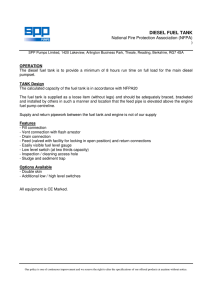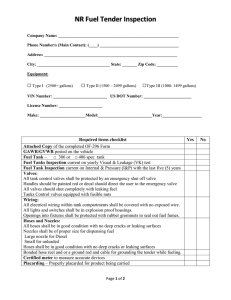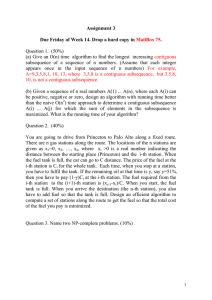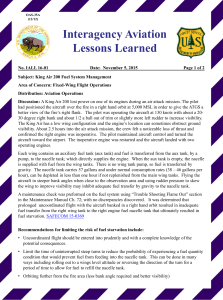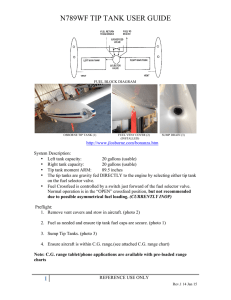TAKE-HOME PART OF THE FINAL EXAM FOR
advertisement
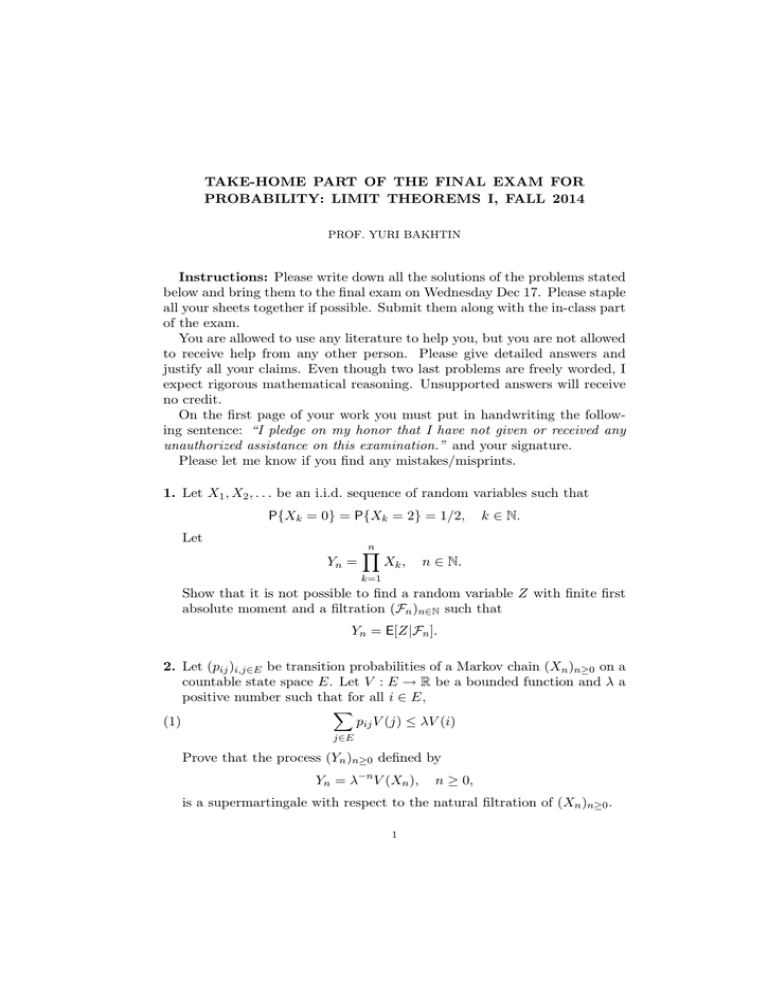
TAKE-HOME PART OF THE FINAL EXAM FOR
PROBABILITY: LIMIT THEOREMS I, FALL 2014
PROF. YURI BAKHTIN
Instructions: Please write down all the solutions of the problems stated
below and bring them to the final exam on Wednesday Dec 17. Please staple
all your sheets together if possible. Submit them along with the in-class part
of the exam.
You are allowed to use any literature to help you, but you are not allowed
to receive help from any other person. Please give detailed answers and
justify all your claims. Even though two last problems are freely worded, I
expect rigorous mathematical reasoning. Unsupported answers will receive
no credit.
On the first page of your work you must put in handwriting the following sentence: “I pledge on my honor that I have not given or received any
unauthorized assistance on this examination.” and your signature.
Please let me know if you find any mistakes/misprints.
1. Let X1 , X2 , . . . be an i.i.d. sequence of random variables such that
P{Xk = 0} = P{Xk = 2} = 1/2,
Let
Yn =
n
Y
Xk ,
k ∈ N.
n ∈ N.
k=1
Show that it is not possible to find a random variable Z with finite first
absolute moment and a filtration (Fn )n∈N such that
Yn = E[Z|Fn ].
2. Let (pij )i,j∈E be transition probabilities of a Markov chain (Xn )n≥0 on a
countable state space E. Let V : E → R be a bounded function and λ a
positive number such that for all i ∈ E,
X
(1)
pij V (j) ≤ λV (i)
j∈E
Prove that the process (Yn )n≥0 defined by
Yn = λ−n V (Xn ),
n ≥ 0,
is a supermartingale with respect to the natural filtration of (Xn )n≥0 .
1
2
PROF. YURI BAKHTIN
3. Use the previous problem to prove the following transience condition for
a Markov chain. Let (pij ) be a transition probability of a Markov chain
(Xn ) on E = Zd for some d ≥ 0. Let V be a positive function on Zd
satisfying V (i) → 0 as |i| → ∞. Suppose that there is a number R > 0
such that for |i| > R, V satisfies inequality (1) from the statement of the
previous problem with λ = 1. Then
Pi {τR < ∞} < 1
for large values of |i|, where
τR = min{n ∈ N : |Xn | ≤ R}.
Hint: consider a sequence of stopping times τR ∧ N , N ∈ N, and use
the optional stopping theorem.
4. In this course, we obtained Gaussian scaling limit (CLT) for sums of i.i.d.
r.v.’s. It turned out that the correct way to rescale is to mutiply the n-th
partial sum by n−1/2 . Summation of r.v.’s is an important model, but
there are numerous other examples of various probabilistic models where
distributional scaling limits exist. The following is one such example that
allows to compute the limiting distribution function directly, without
using integral transforms such as characteristic functions.
Suppose there are infinitely many gold mines along a road. You are
at the beginning of the road, and it takes k weeks to reach k-th gold
mine. When you reach the k-th gold mine you may decide to settle there
and then it steadily will produce Xk oz of gold per week for you, where
(Xk )∞
k=1 is a sequence of i.i.d. r.v.’s each uniformly distributed on [0, 1].
You must get back with all that gold back to the start, and it will take
you another k weeks. Before starting your journey, you know the values
of all Xk ’s and the total time n (weeks) that you will be traveling and/or
exploiting one of the mines. You need to maximize the total gold that
you will get. In more mathematical terms, we set
Yn = max {(n − 2k)Xk },
1≤k≤n/2
n ∈ N.
On the one hand, you want to get to better values of Xk , and if k is too
small, you may miss best gold mines within reach. On the other hand, if
k is too large, you will spend a lot of time traveling and only short time
collecting gold.
a.s.
P
(a) Prove that Yn ≤ n, and as n → ∞, Yn /n → 1.
(b) Find α such that nα (Yn − n) converges in distribution to a nonconstant random variable, and find the limiting distribution. What can
be said about the behavior of the optimal location k = kn providing
the maximum value in the definition of Yn ?
PROBABILITY: LIMIT THEOREMS I, FALL 2014
3
5. A car moves on an infinite road from left to right with constant speed
and constant fuel consumption per mile. At mile 0, it has enough fuel to
drive for 500 miles. At random locations Xk , k ∈ N, along the road there
are canisters (one canister per location) each containing enough fuel to
drive for 100 miles. When the car reaches such a location, the driver
pours all the fuel from the canister into the tank of the car. We assume
that the tank has infinite volume, the fuel consumption does not depend
on the amount of fuel in the tank, and no loss of fuel occurs when the
canisters are used to refill the tank. The random locations Xk are such
that the spacings
(
Xk − Xk−1 , k ≥ 2,
Yk =
X1 ,
k = 1.
between them are i.i.d. positive nonconstant random variables. Let
I = {the car idefinitely drives to the right and never runs out of gas}.
Find a necessary and sufficient conditions in terms of EY1 for P(I) > 0.


